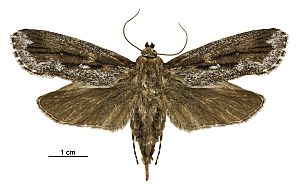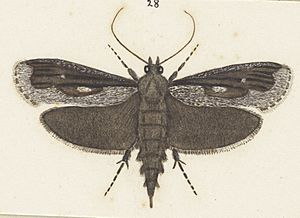Frosted phoenix facts for kids
Quick facts for kids Titanomis |
|
|---|---|
 |
|
| Female | |
| Scientific classification | |
| Kingdom: | |
| Phylum: | |
| Class: | |
| Order: | |
| Family: |
Unassigned
|
| Genus: |
Titanomis
Meyrick, 1888
|
| Species: |
T. sisyrota
|
| Binomial name | |
| Titanomis sisyrota Meyrick, 1888
|
|
| Synonyms | |
|
|
The Titanomis is a special type of moth found only in New Zealand. It has only one known species, called Titanomis sisyrota, which is also known as the frosted phoenix. This moth is super rare! Only ten of them have ever been found, and none have been seen since 1959. Because it's so hard to find, experts aren't sure how many are left. The Department of Conservation in New Zealand has listed it as "Data Deficient." This means they don't have enough information to know if it's endangered or not.
Contents
Discovering the Frosted Phoenix Moth
The Titanomis moth is a bit of a mystery to scientists. It's so unique that it might even need its own special family group! The first time this moth was officially described was in 1888 by a scientist named Edward Meyrick. He used a moth specimen that was collected by another scientist, George Hudson.
There was a small mix-up about where the very first moth was found. George Hudson wrote in his 1928 book that he caught it in 1882 in Nelson. But the label on the moth specimen, written by Meyrick, said it was collected in Wellington in 1885. Later, another expert, John S. Dugdale, confirmed that Nelson was the correct place. It seems Meyrick got the details of catching the moth confused with when it was sent to him in the United Kingdom. This important first specimen is now kept at the Natural History Museum, London.
The name Titanomis comes from two words: "Titan," meaning giant, and "anomis," meaning unusual. This name was chosen because the moth is quite large and looks different from other moths it was first grouped with. The second part of its name, sisyrota, means "wearing a shaggy garment." This refers to the hairy edges on the back wings of the moth.
What Does the Frosted Phoenix Moth Look Like?
The female Titanomis sisyrota moth is quite large, with a wingspan of about 6.5 centimeters (2.5 inches). Its head, mouthparts, and body are mostly whitish with dark brownish-grey spots. The antennae are brownish-grey, and the abdomen (the back part of its body) is a darker brownish-grey.
Its front wings are long and somewhat rectangular. They are a dark brownish-grey color, but they have white speckles all over, except for a rough stripe down the middle. There are also some black spots on the wing veins. The back wings are brownish-grey with hairy edges.
Scientists think the way this moth looks might help it hide in its environment. The whitish parts of its wings could help it blend in with spotted tree bark, suggesting it might live in forests.
Where Does the Frosted Phoenix Moth Live?
The Titanomis sisyrota is known to live only in New Zealand. However, it's an incredibly rare moth, with only 10 confirmed sightings ever! Because it's been found in such scattered places and so rarely, some scientists wonder if it might sometimes fly in from other places, though this is just a guess.
This moth has been found in several areas across New Zealand, including Waikato, Taupō, Wellington, Nelson, Marlborough, Westland, and Southland. The earliest moth was caught in Greymouth in December 1874. Other sightings include Blenheim in 1883, Otaki in 1886, and Rangataua in 1921. The very last time this species was seen was in 1959, near the Waipapa Dam.
Life and Habits of the Frosted Phoenix Moth
We don't know much about the life of the Titanomis sisyrota moth. Adult moths have been seen flying from December to March. They seem to be attracted to light. At least two moths were found inside living rooms, and another was seen near the bright floodlights of the Waipapa Dam. Based on these observations, some scientists think the adult moths might prefer weaker or less bright lights, especially those without much ultraviolet light.
What Does the Frosted Phoenix Moth Eat?
Scientists are still trying to figure out what the caterpillars of the Titanomis sisyrota moth eat. Based on the moth's body shape, it's thought that the female moths might lay their eggs inside woody branches or stems of living plants, rotten wood, or even a type of mushroom called a bracket fungus.
Many of the places where these moths have been found are near beech forests. It's also been suggested that the caterpillars might live in rotten wood from podocarp trees, like kahikatea and matai trees, which are often found in valley floor forests. The moth found in 1959 was also near a kanuka forest. Some experts even think this moth might live in wetland areas. This idea comes from the fact that more female moths are seen attracted to light than males, which is common for species that feed on scattered food sources often found in wetlands.
Protecting the Frosted Phoenix Moth
The Titanomis sisyrota moth is listed as "Data Deficient" under the New Zealand Threat Classification System. This means there isn't enough information to decide its exact conservation status. Since no moths have been seen for over 50 years, some people worry that the species might already be extinct. However, other experts believe it's too early to say for sure. They point out that there aren't many moth scientists in New Zealand actively looking for this specific species, so it might still be out there, just very hard to find.



